Capital Asset Pricing Model: Assumptions, Limitations, and Use
VerifiedAdded on 2023/06/05
|9
|2680
|211
Report
AI Summary
This report provides a detailed analysis of the Capital Asset Pricing Model (CAPM), a widely used financial tool for pricing securities with higher risk. It explores the model's core principles, including its formula for calculating expected return based on risk-free rate, beta, and market return. The report highlights the key assumptions underlying the CAPM, such as perfect markets, risk-averse investors, and efficient information access, while also acknowledging their unrealistic nature. It delves into the limitations of the CAPM, including the presence of transaction costs, varying market participants, and the challenges in accurately measuring beta. Despite these limitations, the report explains why the CAPM remains popular in the industry, citing its simplicity, consideration of systematic risk, and theoretical connection between risk and return. The report also touches upon alternative models like the Fama-French three-factor model and concludes by acknowledging the CAPM's enduring influence on modern finance.

Paraphrase This Document
Need a fresh take? Get an instant paraphrase of this document with our AI Paraphraser
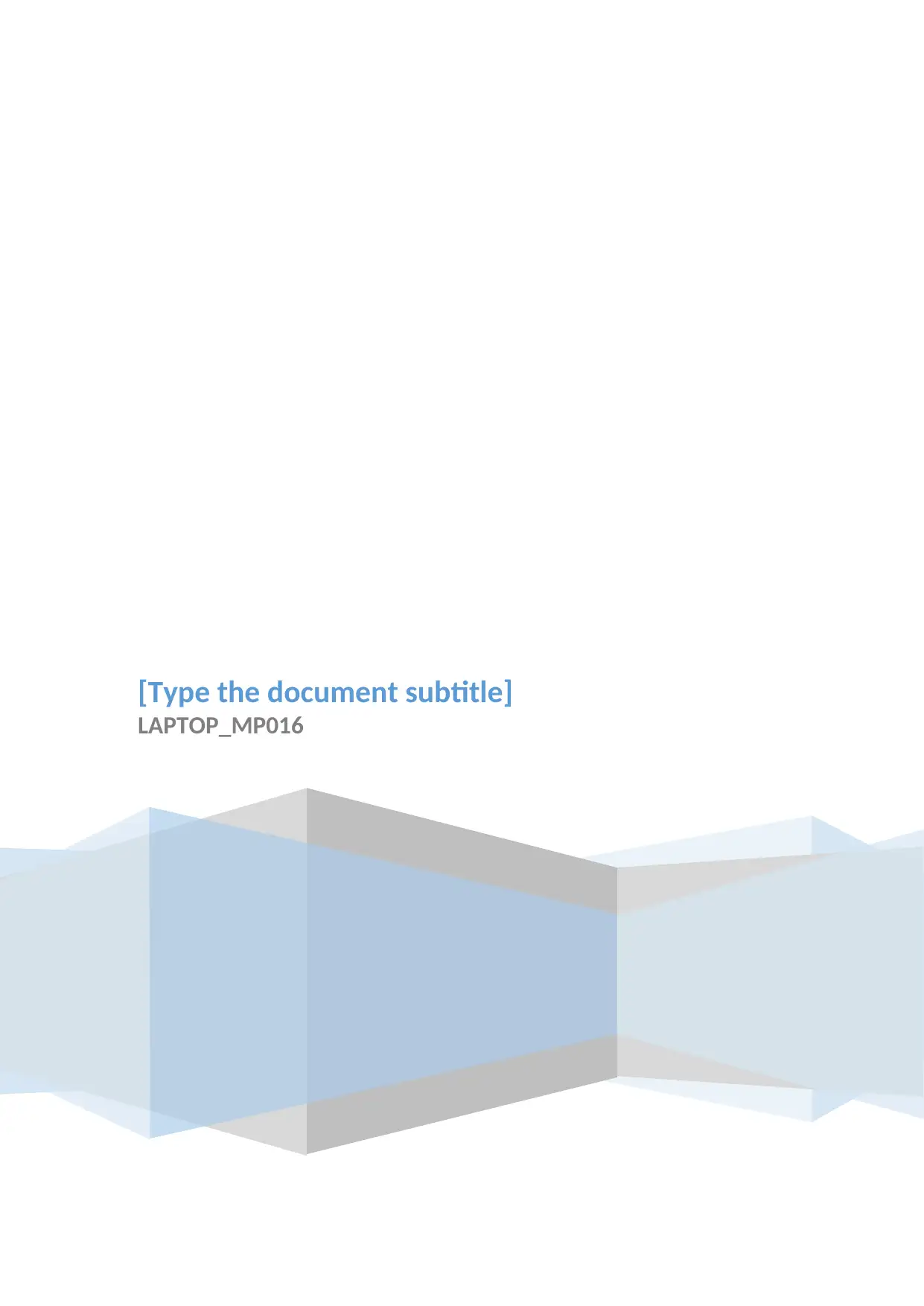
[Type the document subtitle]
LAPTOP_MP016
LAPTOP_MP016
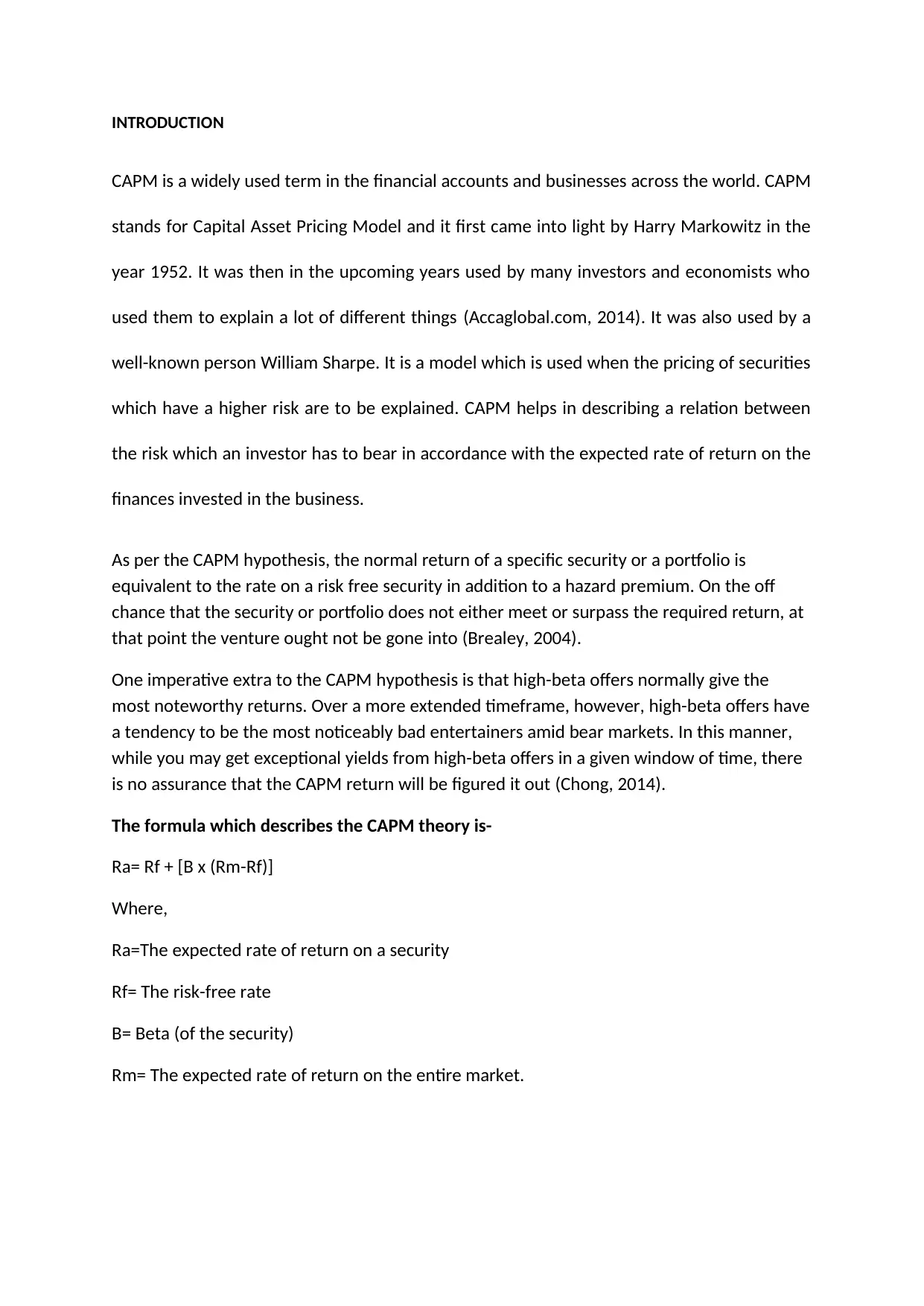
INTRODUCTION
CAPM is a widely used term in the financial accounts and businesses across the world. CAPM
stands for Capital Asset Pricing Model and it first came into light by Harry Markowitz in the
year 1952. It was then in the upcoming years used by many investors and economists who
used them to explain a lot of different things (Accaglobal.com, 2014). It was also used by a
well-known person William Sharpe. It is a model which is used when the pricing of securities
which have a higher risk are to be explained. CAPM helps in describing a relation between
the risk which an investor has to bear in accordance with the expected rate of return on the
finances invested in the business.
As per the CAPM hypothesis, the normal return of a specific security or a portfolio is
equivalent to the rate on a risk free security in addition to a hazard premium. On the off
chance that the security or portfolio does not either meet or surpass the required return, at
that point the venture ought not be gone into (Brealey, 2004).
One imperative extra to the CAPM hypothesis is that high-beta offers normally give the
most noteworthy returns. Over a more extended timeframe, however, high-beta offers have
a tendency to be the most noticeably bad entertainers amid bear markets. In this manner,
while you may get exceptional yields from high-beta offers in a given window of time, there
is no assurance that the CAPM return will be figured it out (Chong, 2014).
The formula which describes the CAPM theory is-
Ra= Rf + [B x (Rm-Rf)]
Where,
Ra=The expected rate of return on a security
Rf= The risk-free rate
B= Beta (of the security)
Rm= The expected rate of return on the entire market.
CAPM is a widely used term in the financial accounts and businesses across the world. CAPM
stands for Capital Asset Pricing Model and it first came into light by Harry Markowitz in the
year 1952. It was then in the upcoming years used by many investors and economists who
used them to explain a lot of different things (Accaglobal.com, 2014). It was also used by a
well-known person William Sharpe. It is a model which is used when the pricing of securities
which have a higher risk are to be explained. CAPM helps in describing a relation between
the risk which an investor has to bear in accordance with the expected rate of return on the
finances invested in the business.
As per the CAPM hypothesis, the normal return of a specific security or a portfolio is
equivalent to the rate on a risk free security in addition to a hazard premium. On the off
chance that the security or portfolio does not either meet or surpass the required return, at
that point the venture ought not be gone into (Brealey, 2004).
One imperative extra to the CAPM hypothesis is that high-beta offers normally give the
most noteworthy returns. Over a more extended timeframe, however, high-beta offers have
a tendency to be the most noticeably bad entertainers amid bear markets. In this manner,
while you may get exceptional yields from high-beta offers in a given window of time, there
is no assurance that the CAPM return will be figured it out (Chong, 2014).
The formula which describes the CAPM theory is-
Ra= Rf + [B x (Rm-Rf)]
Where,
Ra=The expected rate of return on a security
Rf= The risk-free rate
B= Beta (of the security)
Rm= The expected rate of return on the entire market.
⊘ This is a preview!⊘
Do you want full access?
Subscribe today to unlock all pages.

Trusted by 1+ million students worldwide
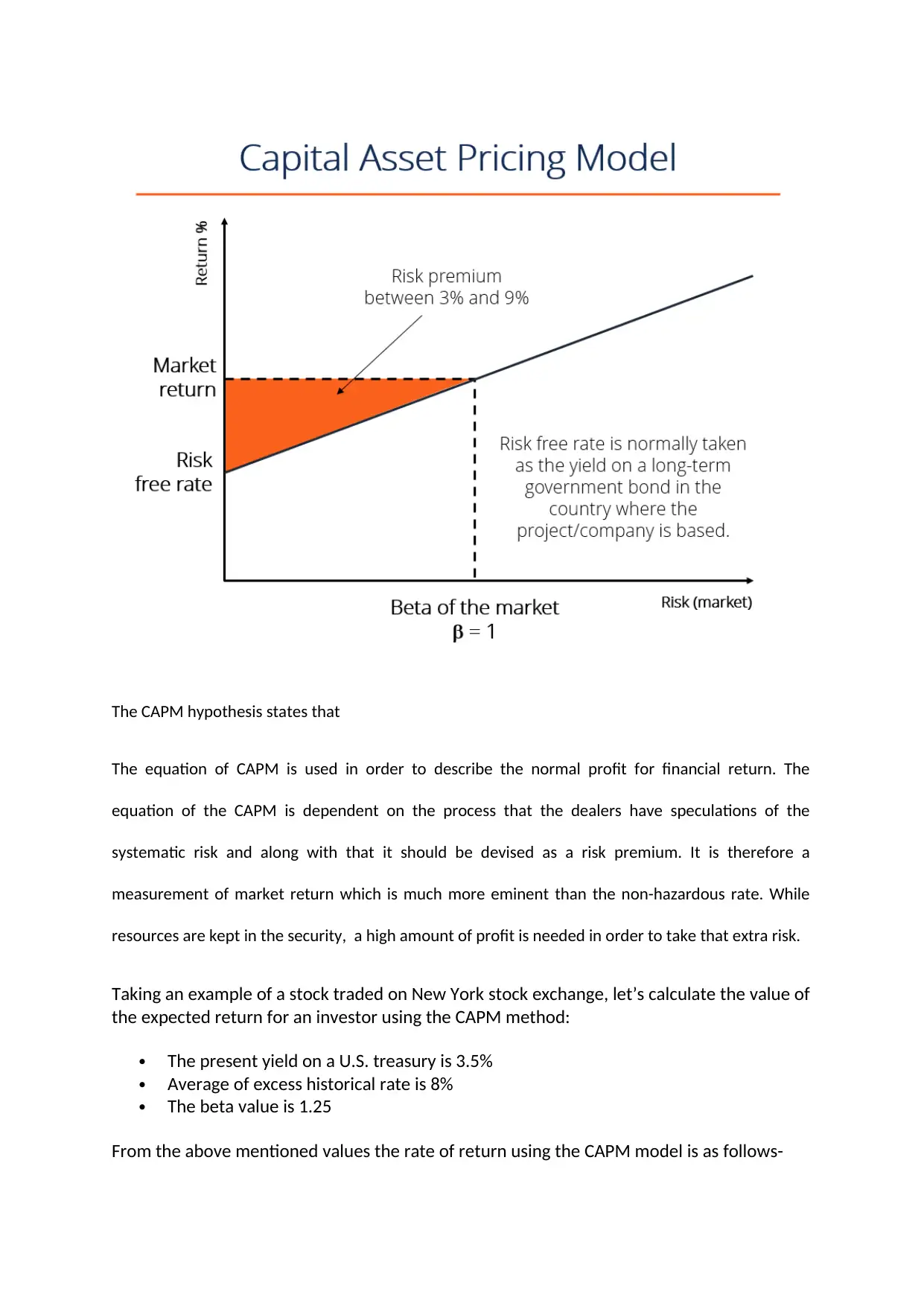
The CAPM hypothesis states that
The equation of CAPM is used in order to describe the normal profit for financial return. The
equation of the CAPM is dependent on the process that the dealers have speculations of the
systematic risk and along with that it should be devised as a risk premium. It is therefore a
measurement of market return which is much more eminent than the non-hazardous rate. While
resources are kept in the security, a high amount of profit is needed in order to take that extra risk.
Taking an example of a stock traded on New York stock exchange, let’s calculate the value of
the expected return for an investor using the CAPM method:
The present yield on a U.S. treasury is 3.5%
Average of excess historical rate is 8%
The beta value is 1.25
From the above mentioned values the rate of return using the CAPM model is as follows-
The equation of CAPM is used in order to describe the normal profit for financial return. The
equation of the CAPM is dependent on the process that the dealers have speculations of the
systematic risk and along with that it should be devised as a risk premium. It is therefore a
measurement of market return which is much more eminent than the non-hazardous rate. While
resources are kept in the security, a high amount of profit is needed in order to take that extra risk.
Taking an example of a stock traded on New York stock exchange, let’s calculate the value of
the expected return for an investor using the CAPM method:
The present yield on a U.S. treasury is 3.5%
Average of excess historical rate is 8%
The beta value is 1.25
From the above mentioned values the rate of return using the CAPM model is as follows-
Paraphrase This Document
Need a fresh take? Get an instant paraphrase of this document with our AI Paraphraser
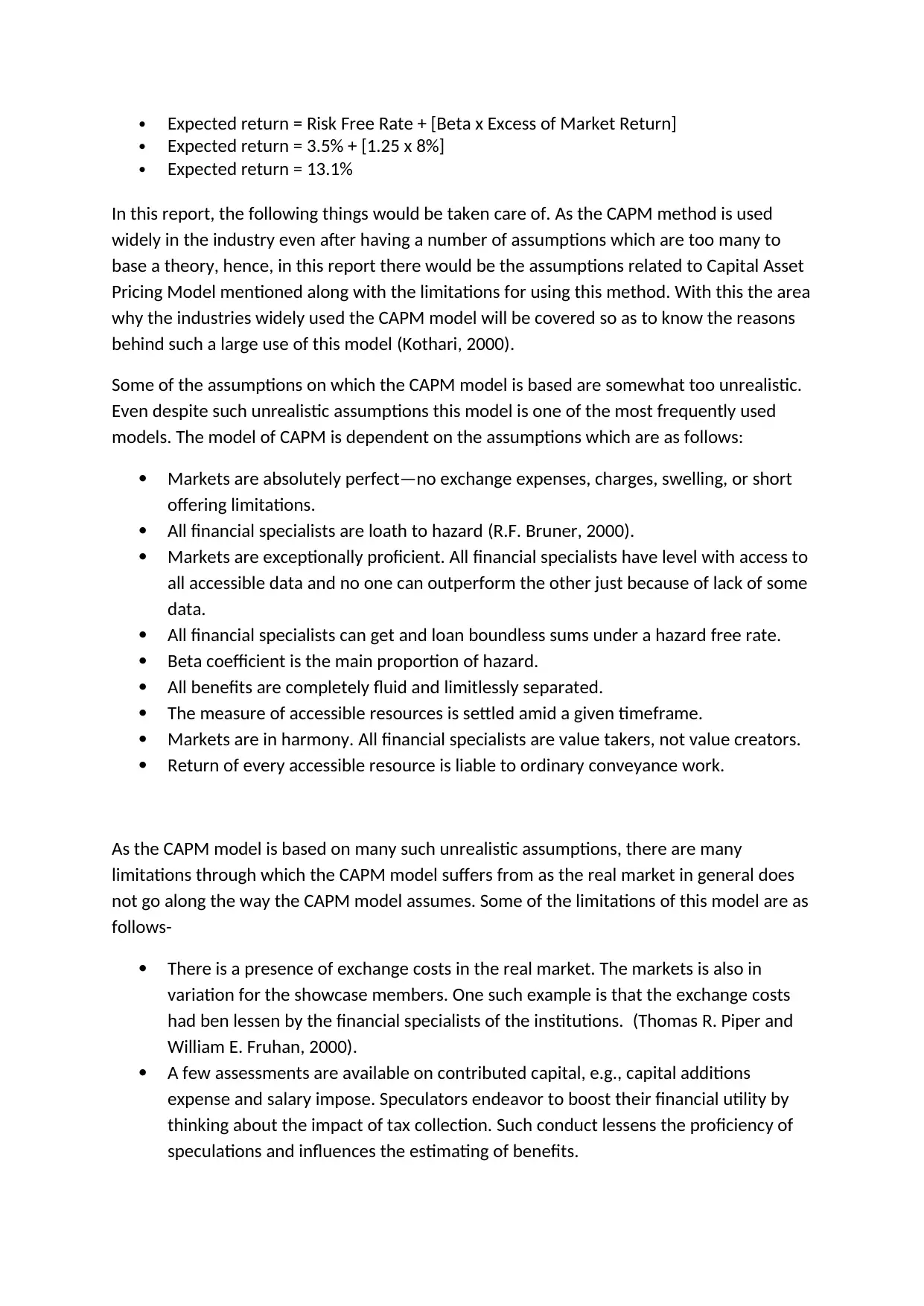
Expected return = Risk Free Rate + [Beta x Excess of Market Return]
Expected return = 3.5% + [1.25 x 8%]
Expected return = 13.1%
In this report, the following things would be taken care of. As the CAPM method is used
widely in the industry even after having a number of assumptions which are too many to
base a theory, hence, in this report there would be the assumptions related to Capital Asset
Pricing Model mentioned along with the limitations for using this method. With this the area
why the industries widely used the CAPM model will be covered so as to know the reasons
behind such a large use of this model (Kothari, 2000).
Some of the assumptions on which the CAPM model is based are somewhat too unrealistic.
Even despite such unrealistic assumptions this model is one of the most frequently used
models. The model of CAPM is dependent on the assumptions which are as follows:
Markets are absolutely perfect—no exchange expenses, charges, swelling, or short
offering limitations.
All financial specialists are loath to hazard (R.F. Bruner, 2000).
Markets are exceptionally proficient. All financial specialists have level with access to
all accessible data and no one can outperform the other just because of lack of some
data.
All financial specialists can get and loan boundless sums under a hazard free rate.
Beta coefficient is the main proportion of hazard.
All benefits are completely fluid and limitlessly separated.
The measure of accessible resources is settled amid a given timeframe.
Markets are in harmony. All financial specialists are value takers, not value creators.
Return of every accessible resource is liable to ordinary conveyance work.
As the CAPM model is based on many such unrealistic assumptions, there are many
limitations through which the CAPM model suffers from as the real market in general does
not go along the way the CAPM model assumes. Some of the limitations of this model are as
follows-
There is a presence of exchange costs in the real market. The markets is also in
variation for the showcase members. One such example is that the exchange costs
had ben lessen by the financial specialists of the institutions. (Thomas R. Piper and
William E. Fruhan, 2000).
A few assessments are available on contributed capital, e.g., capital additions
expense and salary impose. Speculators endeavor to boost their financial utility by
thinking about the impact of tax collection. Such conduct lessens the proficiency of
speculations and influences the estimating of benefits.
Expected return = 3.5% + [1.25 x 8%]
Expected return = 13.1%
In this report, the following things would be taken care of. As the CAPM method is used
widely in the industry even after having a number of assumptions which are too many to
base a theory, hence, in this report there would be the assumptions related to Capital Asset
Pricing Model mentioned along with the limitations for using this method. With this the area
why the industries widely used the CAPM model will be covered so as to know the reasons
behind such a large use of this model (Kothari, 2000).
Some of the assumptions on which the CAPM model is based are somewhat too unrealistic.
Even despite such unrealistic assumptions this model is one of the most frequently used
models. The model of CAPM is dependent on the assumptions which are as follows:
Markets are absolutely perfect—no exchange expenses, charges, swelling, or short
offering limitations.
All financial specialists are loath to hazard (R.F. Bruner, 2000).
Markets are exceptionally proficient. All financial specialists have level with access to
all accessible data and no one can outperform the other just because of lack of some
data.
All financial specialists can get and loan boundless sums under a hazard free rate.
Beta coefficient is the main proportion of hazard.
All benefits are completely fluid and limitlessly separated.
The measure of accessible resources is settled amid a given timeframe.
Markets are in harmony. All financial specialists are value takers, not value creators.
Return of every accessible resource is liable to ordinary conveyance work.
As the CAPM model is based on many such unrealistic assumptions, there are many
limitations through which the CAPM model suffers from as the real market in general does
not go along the way the CAPM model assumes. Some of the limitations of this model are as
follows-
There is a presence of exchange costs in the real market. The markets is also in
variation for the showcase members. One such example is that the exchange costs
had ben lessen by the financial specialists of the institutions. (Thomas R. Piper and
William E. Fruhan, 2000).
A few assessments are available on contributed capital, e.g., capital additions
expense and salary impose. Speculators endeavor to boost their financial utility by
thinking about the impact of tax collection. Such conduct lessens the proficiency of
speculations and influences the estimating of benefits.
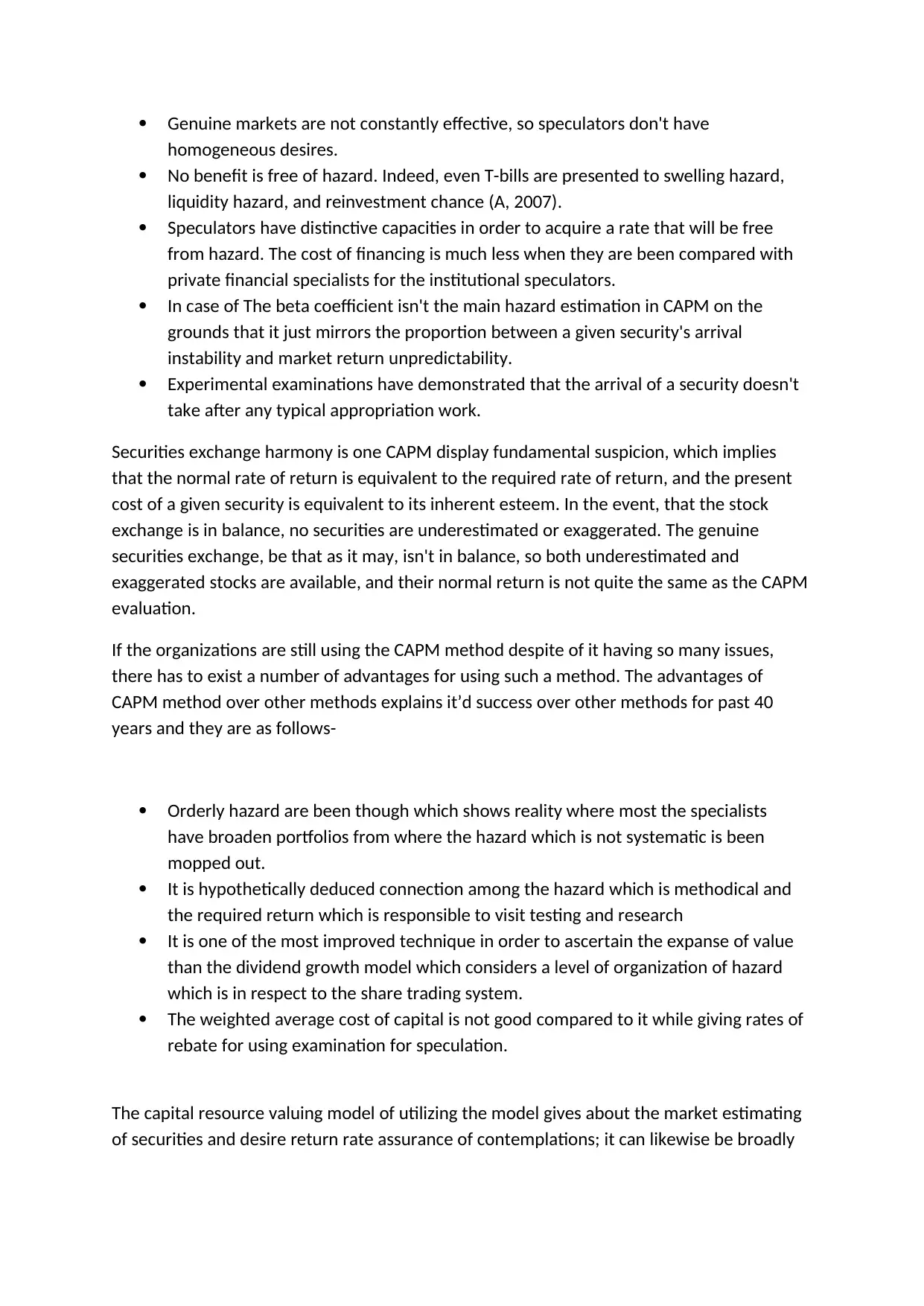
Genuine markets are not constantly effective, so speculators don't have
homogeneous desires.
No benefit is free of hazard. Indeed, even T-bills are presented to swelling hazard,
liquidity hazard, and reinvestment chance (A, 2007).
Speculators have distinctive capacities in order to acquire a rate that will be free
from hazard. The cost of financing is much less when they are been compared with
private financial specialists for the institutional speculators.
In case of The beta coefficient isn't the main hazard estimation in CAPM on the
grounds that it just mirrors the proportion between a given security's arrival
instability and market return unpredictability.
Experimental examinations have demonstrated that the arrival of a security doesn't
take after any typical appropriation work.
Securities exchange harmony is one CAPM display fundamental suspicion, which implies
that the normal rate of return is equivalent to the required rate of return, and the present
cost of a given security is equivalent to its inherent esteem. In the event, that the stock
exchange is in balance, no securities are underestimated or exaggerated. The genuine
securities exchange, be that as it may, isn't in balance, so both underestimated and
exaggerated stocks are available, and their normal return is not quite the same as the CAPM
evaluation.
If the organizations are still using the CAPM method despite of it having so many issues,
there has to exist a number of advantages for using such a method. The advantages of
CAPM method over other methods explains it’d success over other methods for past 40
years and they are as follows-
Orderly hazard are been though which shows reality where most the specialists
have broaden portfolios from where the hazard which is not systematic is been
mopped out.
It is hypothetically deduced connection among the hazard which is methodical and
the required return which is responsible to visit testing and research
It is one of the most improved technique in order to ascertain the expanse of value
than the dividend growth model which considers a level of organization of hazard
which is in respect to the share trading system.
The weighted average cost of capital is not good compared to it while giving rates of
rebate for using examination for speculation.
The capital resource valuing model of utilizing the model gives about the market estimating
of securities and desire return rate assurance of contemplations; it can likewise be broadly
homogeneous desires.
No benefit is free of hazard. Indeed, even T-bills are presented to swelling hazard,
liquidity hazard, and reinvestment chance (A, 2007).
Speculators have distinctive capacities in order to acquire a rate that will be free
from hazard. The cost of financing is much less when they are been compared with
private financial specialists for the institutional speculators.
In case of The beta coefficient isn't the main hazard estimation in CAPM on the
grounds that it just mirrors the proportion between a given security's arrival
instability and market return unpredictability.
Experimental examinations have demonstrated that the arrival of a security doesn't
take after any typical appropriation work.
Securities exchange harmony is one CAPM display fundamental suspicion, which implies
that the normal rate of return is equivalent to the required rate of return, and the present
cost of a given security is equivalent to its inherent esteem. In the event, that the stock
exchange is in balance, no securities are underestimated or exaggerated. The genuine
securities exchange, be that as it may, isn't in balance, so both underestimated and
exaggerated stocks are available, and their normal return is not quite the same as the CAPM
evaluation.
If the organizations are still using the CAPM method despite of it having so many issues,
there has to exist a number of advantages for using such a method. The advantages of
CAPM method over other methods explains it’d success over other methods for past 40
years and they are as follows-
Orderly hazard are been though which shows reality where most the specialists
have broaden portfolios from where the hazard which is not systematic is been
mopped out.
It is hypothetically deduced connection among the hazard which is methodical and
the required return which is responsible to visit testing and research
It is one of the most improved technique in order to ascertain the expanse of value
than the dividend growth model which considers a level of organization of hazard
which is in respect to the share trading system.
The weighted average cost of capital is not good compared to it while giving rates of
rebate for using examination for speculation.
The capital resource valuing model of utilizing the model gives about the market estimating
of securities and desire return rate assurance of contemplations; it can likewise be broadly
⊘ This is a preview!⊘
Do you want full access?
Subscribe today to unlock all pages.

Trusted by 1+ million students worldwide
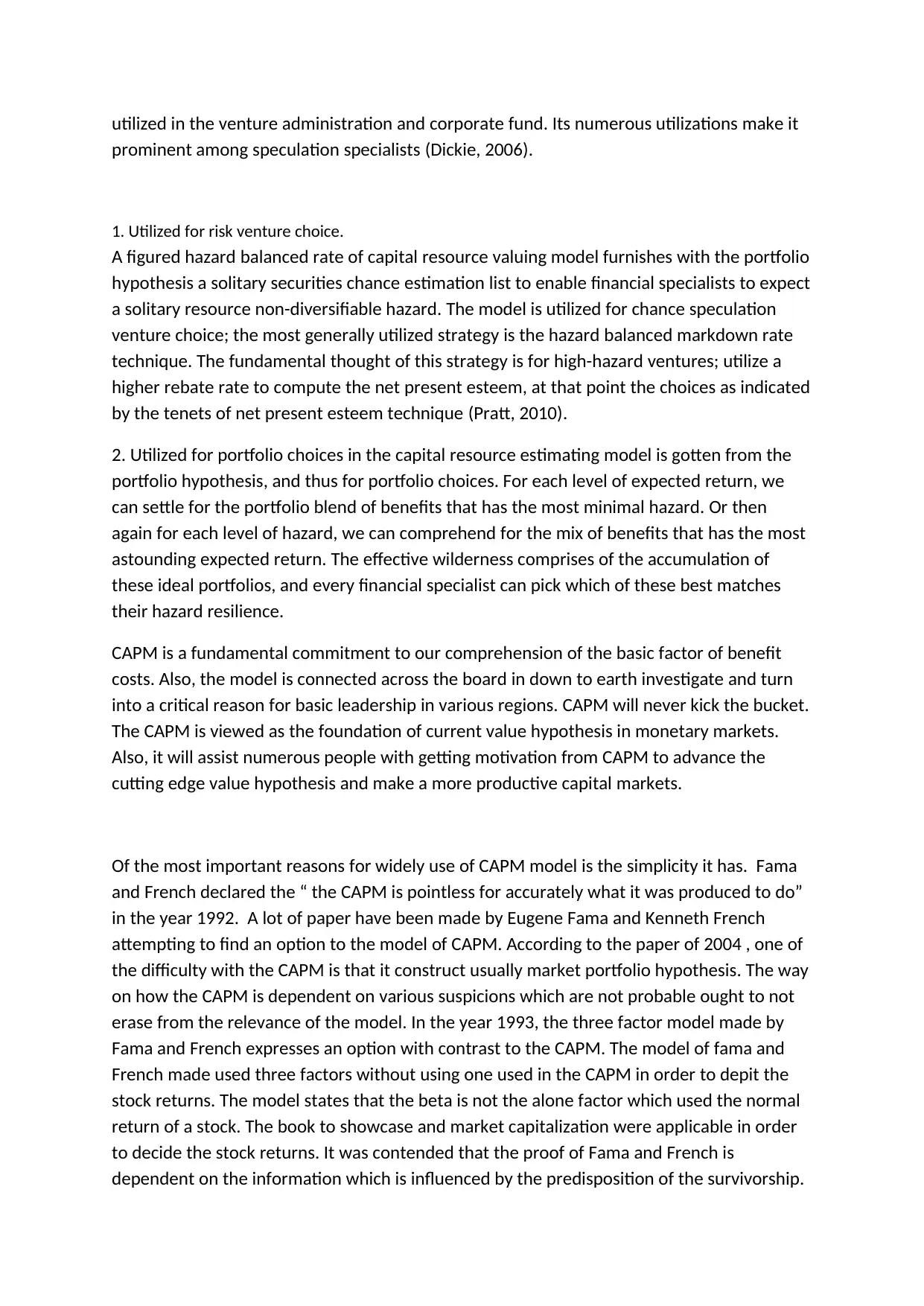
utilized in the venture administration and corporate fund. Its numerous utilizations make it
prominent among speculation specialists (Dickie, 2006).
1. Utilized for risk venture choice.
A figured hazard balanced rate of capital resource valuing model furnishes with the portfolio
hypothesis a solitary securities chance estimation list to enable financial specialists to expect
a solitary resource non-diversifiable hazard. The model is utilized for chance speculation
venture choice; the most generally utilized strategy is the hazard balanced markdown rate
technique. The fundamental thought of this strategy is for high-hazard ventures; utilize a
higher rebate rate to compute the net present esteem, at that point the choices as indicated
by the tenets of net present esteem technique (Pratt, 2010).
2. Utilized for portfolio choices in the capital resource estimating model is gotten from the
portfolio hypothesis, and thus for portfolio choices. For each level of expected return, we
can settle for the portfolio blend of benefits that has the most minimal hazard. Or then
again for each level of hazard, we can comprehend for the mix of benefits that has the most
astounding expected return. The effective wilderness comprises of the accumulation of
these ideal portfolios, and every financial specialist can pick which of these best matches
their hazard resilience.
CAPM is a fundamental commitment to our comprehension of the basic factor of benefit
costs. Also, the model is connected across the board in down to earth investigate and turn
into a critical reason for basic leadership in various regions. CAPM will never kick the bucket.
The CAPM is viewed as the foundation of current value hypothesis in monetary markets.
Also, it will assist numerous people with getting motivation from CAPM to advance the
cutting edge value hypothesis and make a more productive capital markets.
Of the most important reasons for widely use of CAPM model is the simplicity it has. Fama
and French declared the “ the CAPM is pointless for accurately what it was produced to do”
in the year 1992. A lot of paper have been made by Eugene Fama and Kenneth French
attempting to find an option to the model of CAPM. According to the paper of 2004 , one of
the difficulty with the CAPM is that it construct usually market portfolio hypothesis. The way
on how the CAPM is dependent on various suspicions which are not probable ought to not
erase from the relevance of the model. In the year 1993, the three factor model made by
Fama and French expresses an option with contrast to the CAPM. The model of fama and
French made used three factors without using one used in the CAPM in order to depit the
stock returns. The model states that the beta is not the alone factor which used the normal
return of a stock. The book to showcase and market capitalization were applicable in order
to decide the stock returns. It was contended that the proof of Fama and French is
dependent on the information which is influenced by the predisposition of the survivorship.
prominent among speculation specialists (Dickie, 2006).
1. Utilized for risk venture choice.
A figured hazard balanced rate of capital resource valuing model furnishes with the portfolio
hypothesis a solitary securities chance estimation list to enable financial specialists to expect
a solitary resource non-diversifiable hazard. The model is utilized for chance speculation
venture choice; the most generally utilized strategy is the hazard balanced markdown rate
technique. The fundamental thought of this strategy is for high-hazard ventures; utilize a
higher rebate rate to compute the net present esteem, at that point the choices as indicated
by the tenets of net present esteem technique (Pratt, 2010).
2. Utilized for portfolio choices in the capital resource estimating model is gotten from the
portfolio hypothesis, and thus for portfolio choices. For each level of expected return, we
can settle for the portfolio blend of benefits that has the most minimal hazard. Or then
again for each level of hazard, we can comprehend for the mix of benefits that has the most
astounding expected return. The effective wilderness comprises of the accumulation of
these ideal portfolios, and every financial specialist can pick which of these best matches
their hazard resilience.
CAPM is a fundamental commitment to our comprehension of the basic factor of benefit
costs. Also, the model is connected across the board in down to earth investigate and turn
into a critical reason for basic leadership in various regions. CAPM will never kick the bucket.
The CAPM is viewed as the foundation of current value hypothesis in monetary markets.
Also, it will assist numerous people with getting motivation from CAPM to advance the
cutting edge value hypothesis and make a more productive capital markets.
Of the most important reasons for widely use of CAPM model is the simplicity it has. Fama
and French declared the “ the CAPM is pointless for accurately what it was produced to do”
in the year 1992. A lot of paper have been made by Eugene Fama and Kenneth French
attempting to find an option to the model of CAPM. According to the paper of 2004 , one of
the difficulty with the CAPM is that it construct usually market portfolio hypothesis. The way
on how the CAPM is dependent on various suspicions which are not probable ought to not
erase from the relevance of the model. In the year 1993, the three factor model made by
Fama and French expresses an option with contrast to the CAPM. The model of fama and
French made used three factors without using one used in the CAPM in order to depit the
stock returns. The model states that the beta is not the alone factor which used the normal
return of a stock. The book to showcase and market capitalization were applicable in order
to decide the stock returns. It was contended that the proof of Fama and French is
dependent on the information which is influenced by the predisposition of the survivorship.
Paraphrase This Document
Need a fresh take? Get an instant paraphrase of this document with our AI Paraphraser
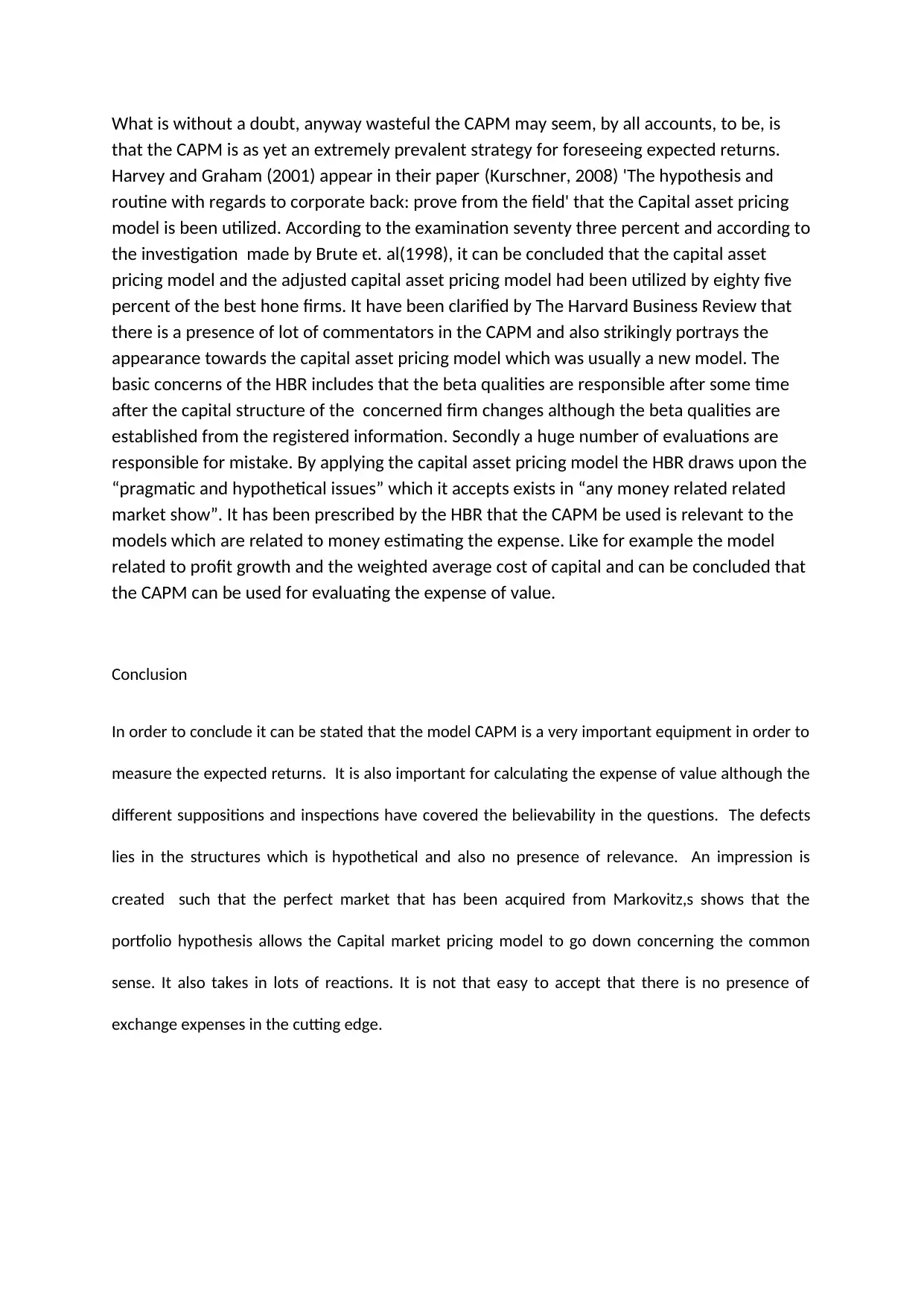
What is without a doubt, anyway wasteful the CAPM may seem, by all accounts, to be, is
that the CAPM is as yet an extremely prevalent strategy for foreseeing expected returns.
Harvey and Graham (2001) appear in their paper (Kurschner, 2008) 'The hypothesis and
routine with regards to corporate back: prove from the field' that the Capital asset pricing
model is been utilized. According to the examination seventy three percent and according to
the investigation made by Brute et. al(1998), it can be concluded that the capital asset
pricing model and the adjusted capital asset pricing model had been utilized by eighty five
percent of the best hone firms. It have been clarified by The Harvard Business Review that
there is a presence of lot of commentators in the CAPM and also strikingly portrays the
appearance towards the capital asset pricing model which was usually a new model. The
basic concerns of the HBR includes that the beta qualities are responsible after some time
after the capital structure of the concerned firm changes although the beta qualities are
established from the registered information. Secondly a huge number of evaluations are
responsible for mistake. By applying the capital asset pricing model the HBR draws upon the
“pragmatic and hypothetical issues” which it accepts exists in “any money related related
market show”. It has been prescribed by the HBR that the CAPM be used is relevant to the
models which are related to money estimating the expense. Like for example the model
related to profit growth and the weighted average cost of capital and can be concluded that
the CAPM can be used for evaluating the expense of value.
Conclusion
In order to conclude it can be stated that the model CAPM is a very important equipment in order to
measure the expected returns. It is also important for calculating the expense of value although the
different suppositions and inspections have covered the believability in the questions. The defects
lies in the structures which is hypothetical and also no presence of relevance. An impression is
created such that the perfect market that has been acquired from Markovitz,s shows that the
portfolio hypothesis allows the Capital market pricing model to go down concerning the common
sense. It also takes in lots of reactions. It is not that easy to accept that there is no presence of
exchange expenses in the cutting edge.
that the CAPM is as yet an extremely prevalent strategy for foreseeing expected returns.
Harvey and Graham (2001) appear in their paper (Kurschner, 2008) 'The hypothesis and
routine with regards to corporate back: prove from the field' that the Capital asset pricing
model is been utilized. According to the examination seventy three percent and according to
the investigation made by Brute et. al(1998), it can be concluded that the capital asset
pricing model and the adjusted capital asset pricing model had been utilized by eighty five
percent of the best hone firms. It have been clarified by The Harvard Business Review that
there is a presence of lot of commentators in the CAPM and also strikingly portrays the
appearance towards the capital asset pricing model which was usually a new model. The
basic concerns of the HBR includes that the beta qualities are responsible after some time
after the capital structure of the concerned firm changes although the beta qualities are
established from the registered information. Secondly a huge number of evaluations are
responsible for mistake. By applying the capital asset pricing model the HBR draws upon the
“pragmatic and hypothetical issues” which it accepts exists in “any money related related
market show”. It has been prescribed by the HBR that the CAPM be used is relevant to the
models which are related to money estimating the expense. Like for example the model
related to profit growth and the weighted average cost of capital and can be concluded that
the CAPM can be used for evaluating the expense of value.
Conclusion
In order to conclude it can be stated that the model CAPM is a very important equipment in order to
measure the expected returns. It is also important for calculating the expense of value although the
different suppositions and inspections have covered the believability in the questions. The defects
lies in the structures which is hypothetical and also no presence of relevance. An impression is
created such that the perfect market that has been acquired from Markovitz,s shows that the
portfolio hypothesis allows the Capital market pricing model to go down concerning the common
sense. It also takes in lots of reactions. It is not that easy to accept that there is no presence of
exchange expenses in the cutting edge.
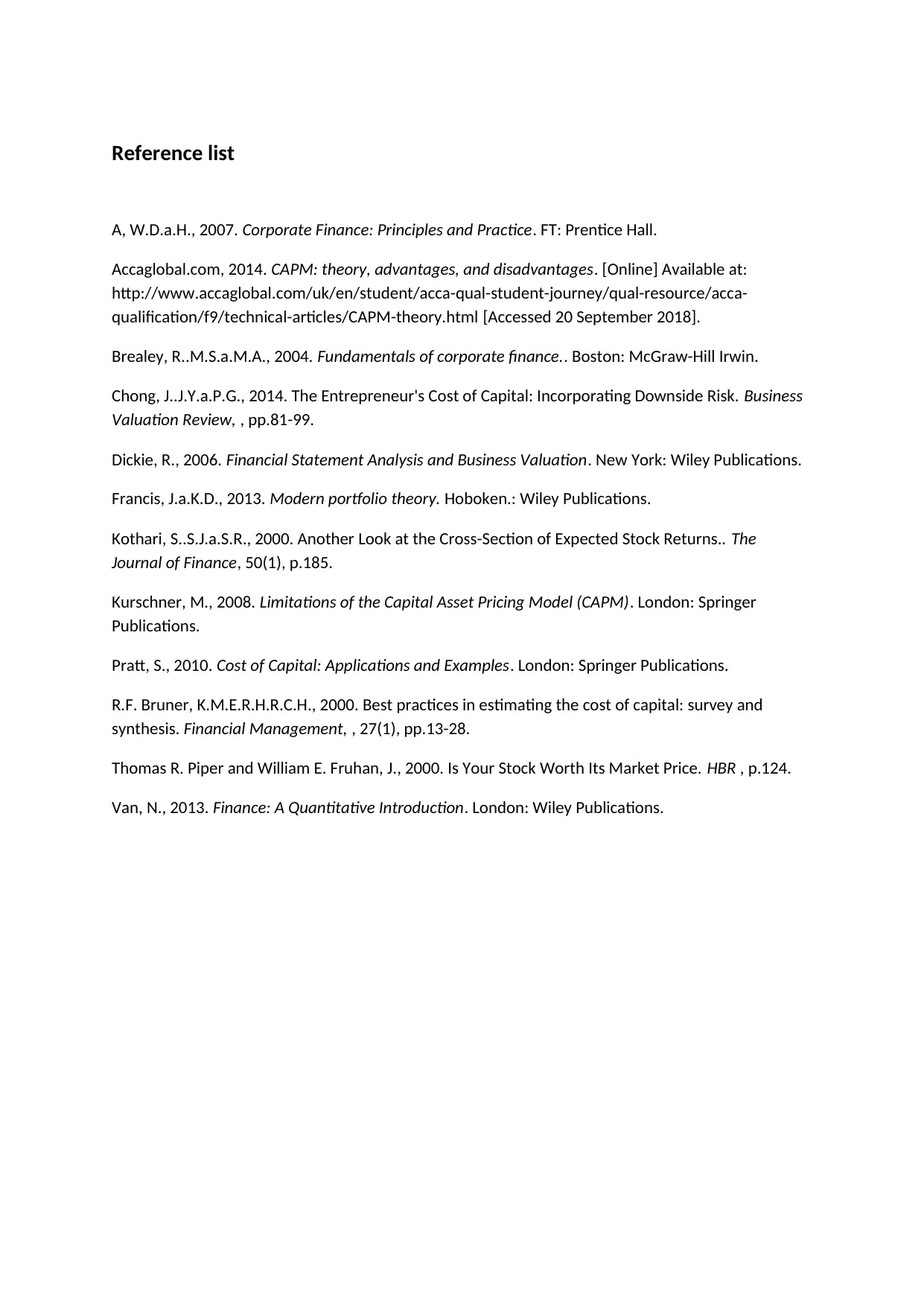
Reference list
A, W.D.a.H., 2007. Corporate Finance: Principles and Practice. FT: Prentice Hall.
Accaglobal.com, 2014. CAPM: theory, advantages, and disadvantages. [Online] Available at:
http://www.accaglobal.com/uk/en/student/acca-qual-student-journey/qual-resource/acca-
qualification/f9/technical-articles/CAPM-theory.html [Accessed 20 September 2018].
Brealey, R..M.S.a.M.A., 2004. Fundamentals of corporate finance.. Boston: McGraw-Hill Irwin.
Chong, J..J.Y.a.P.G., 2014. The Entrepreneur's Cost of Capital: Incorporating Downside Risk. Business
Valuation Review, , pp.81-99.
Dickie, R., 2006. Financial Statement Analysis and Business Valuation. New York: Wiley Publications.
Francis, J.a.K.D., 2013. Modern portfolio theory. Hoboken.: Wiley Publications.
Kothari, S..S.J.a.S.R., 2000. Another Look at the Cross-Section of Expected Stock Returns.. The
Journal of Finance, 50(1), p.185.
Kurschner, M., 2008. Limitations of the Capital Asset Pricing Model (CAPM). London: Springer
Publications.
Pratt, S., 2010. Cost of Capital: Applications and Examples. London: Springer Publications.
R.F. Bruner, K.M.E.R.H.R.C.H., 2000. Best practices in estimating the cost of capital: survey and
synthesis. Financial Management, , 27(1), pp.13-28.
Thomas R. Piper and William E. Fruhan, J., 2000. Is Your Stock Worth Its Market Price. HBR , p.124.
Van, N., 2013. Finance: A Quantitative Introduction. London: Wiley Publications.
A, W.D.a.H., 2007. Corporate Finance: Principles and Practice. FT: Prentice Hall.
Accaglobal.com, 2014. CAPM: theory, advantages, and disadvantages. [Online] Available at:
http://www.accaglobal.com/uk/en/student/acca-qual-student-journey/qual-resource/acca-
qualification/f9/technical-articles/CAPM-theory.html [Accessed 20 September 2018].
Brealey, R..M.S.a.M.A., 2004. Fundamentals of corporate finance.. Boston: McGraw-Hill Irwin.
Chong, J..J.Y.a.P.G., 2014. The Entrepreneur's Cost of Capital: Incorporating Downside Risk. Business
Valuation Review, , pp.81-99.
Dickie, R., 2006. Financial Statement Analysis and Business Valuation. New York: Wiley Publications.
Francis, J.a.K.D., 2013. Modern portfolio theory. Hoboken.: Wiley Publications.
Kothari, S..S.J.a.S.R., 2000. Another Look at the Cross-Section of Expected Stock Returns.. The
Journal of Finance, 50(1), p.185.
Kurschner, M., 2008. Limitations of the Capital Asset Pricing Model (CAPM). London: Springer
Publications.
Pratt, S., 2010. Cost of Capital: Applications and Examples. London: Springer Publications.
R.F. Bruner, K.M.E.R.H.R.C.H., 2000. Best practices in estimating the cost of capital: survey and
synthesis. Financial Management, , 27(1), pp.13-28.
Thomas R. Piper and William E. Fruhan, J., 2000. Is Your Stock Worth Its Market Price. HBR , p.124.
Van, N., 2013. Finance: A Quantitative Introduction. London: Wiley Publications.
⊘ This is a preview!⊘
Do you want full access?
Subscribe today to unlock all pages.

Trusted by 1+ million students worldwide
1 out of 9
Related Documents
Your All-in-One AI-Powered Toolkit for Academic Success.
+13062052269
info@desklib.com
Available 24*7 on WhatsApp / Email
![[object Object]](/_next/static/media/star-bottom.7253800d.svg)
Unlock your academic potential
Copyright © 2020–2025 A2Z Services. All Rights Reserved. Developed and managed by ZUCOL.



